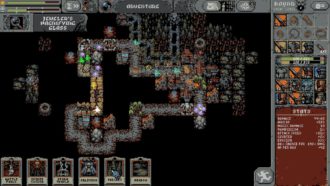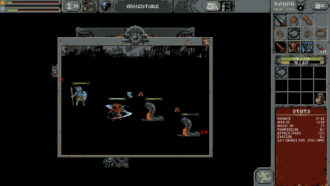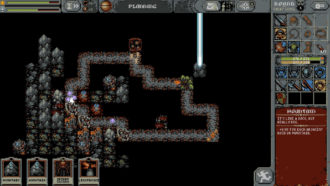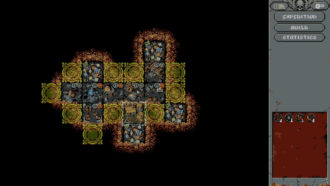Loop Hero is a roguelike deckbuilding game developed by Four Quarters Team and published by Devolver Digital. It tells the story of a world stuck in an endless time loop. Originally Loop Hero began as an entry for Ludum Dare, an online game jam where developers team up to create a game in one weekend. While the Four Quarters developers weren’t able to finish their game in one weekend, they did keep working on it. Thus, Loop Hero was born. Throughout 2019, the developers worked on the alpha version which they eventually released on Itch.io.
Visually, the game doesn’t seem to have changed that much since its Ludum Dare days. The graphics are remarkably simple and, while they may not appeal to everyone, they exude old-school MS Dos charm. These simple graphics belie the complexity of Loop Hero’s game mechanics, however; there’s a lot going on under the surface of this game.
Playing as an unnamed hero, it’s your job to defeat the Lich, the evil force responsible for plunging the current world into chaos. To restore the world’s balance, you’ll need to go on an expedition onto a looped path. Once there, you’ll have to defeat monsters, collect resources, and confront the evil Lich in a fittingly difficult boss battle. Once you finish a run, you’ll have the opportunity to use any collected materials and resources to upgrade a base camp. You can build camp extensions ranging from field kitchens to blacksmiths, all of which can give you an edge for your next run.
While Loop Hero describes itself as a deck-building roguelike adventure, the format of a run is quite unconventional. For starters, a full run will take place on a map consisting of a single path in the shape of a loop. The game has two modes: adventure mode, where your hero walks along the path automatically and takes on any enemies they encounter, and planning mode, where you can pause the game and use any cards you’ve collected to alter the map’s terrain. When playing on adventure mode, you can’t control your hero’s movements directly: any walking, attacking, and defending happens automatically. As your hero progresses through the loop, the days will pass one by one, marked by the sound of a rooster crowing.
Initially, you’ll only have a campfire and some basic enemies on your path. Each time you defeat an enemy, they will drop some gear and/or cards. This is where the planning mode comes in: planning mode allows you to pause the game and use any cards you’ve acquired to alter the terrain on the map, or to equip your hero with better gear. Since all aspects of battle happen automatically, without you having to select certain attack or defence moves, surviving a battle completely depends on the gear you have equipped and the terrain you’re in.
The way that you can alter the map’s terrain depends on the card in question. Some cards will add enemies or forests to your path, while other cards like mountains, meadows or buildings can give you certain bonuses. Lighthouses, for example, give you a movement bonus when you’re in their range and mountains and rocks will let you restore a certain number of health points when you’re close by. Other cards will spawn specific enemies on your path, like mansions containing vampiric lords, dense forests with rat wolves, or chests containing rewards. In any case, it didn’t take long for my map to look like a colourful pixel patchwork full of unique challenges.
…it didn’t take long for my map to look like a colourful pixel patchwork full of unique challenges.
So, how many loops do you need to do to complete a run? That’s up to you! Each time your hero passes the map’s campfire, their health points replenish and a new loop begins. However, the campfire tile also gives you the option to stop and return back to camp whenever you’re standing on it. This can be handy to do once you’ve collected enough resources to upgrade your camp, for example, or if you’re keen to start another run with a new buff from a particular camp upgrade. If you decide to walk past the campfire tile, another loop begins.
The more loops you do, the better gear you pick up and the stronger your enemies become. As you progress and alter your map’s terrain further, you’ll start encountering more complex enemies ranging from wolves, to goblins, to vampires, who will sometimes attack you alone and sometimes in groups. Without wanting to spoil anything: a strange building will appear on the map after a certain amount of time and a boss battle will ensue.
While the game’s format did take me some getting used to, the power of Loop Hero lies in its variety, simplicity, and its replayability value. The game is easy to learn but hard to master, and since your terrain and gear are all dependent on what you can collect throughout a run, no two runs are the same. Its innovative game mechanics mix up the card game format in a remarkably refreshing way. I for one am very much looking forward to what the full release will bring.
Loop Hero will be released in 2021.











